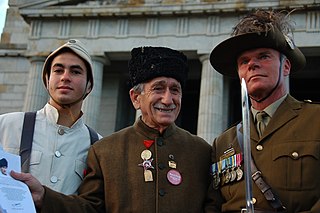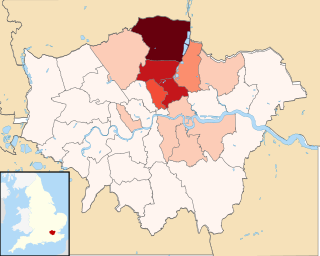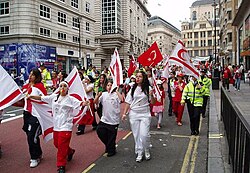
Northern Cyprus, officially the Turkish Republic of Northern Cyprus (TRNC), is a de facto state that comprises the northeastern portion of the island of Cyprus. It is recognised only by Turkey, and its territory is considered by all other states to be part of the Republic of Cyprus.

The Progressive Party of Working People is a Marxist–Leninist communist party in Cyprus.

The Ethniki Organosis Kyprion Agoniston was a Greek Cypriot nationalist guerrilla organization that fought a campaign for the end of British rule in Cyprus, and for eventual union with Greece.
Turkish Cypriots or Cypriot Turks are ethnic Turks originating from Cyprus. Turkish Cypriots are mainly Sunni Muslims. Following the Ottoman conquest of the island in 1571, about 30,000 Turkish settlers were given land once they arrived in Cyprus. Additionally, many of the island's local Christians converted to Islam during the early years of Ottoman rule. Nonetheless, the influx of mainly Muslim settlers to Cyprus continued intermittently until the end of the Ottoman period. Today, while Northern Cyprus is home to a significant part of the Turkish Cypriot population, the majority of Turkish Cypriots live abroad, forming the Turkish Cypriot diaspora. This diaspora came into existence after the Ottoman Empire transferred the control of the island to the British Empire, as many Turkish Cypriots emigrated primarily to Turkey and the United Kingdom for political and economic reasons.

The Turkish invasion of Cyprus began on 20 July 1974 and progressed in two phases over the following month. Taking place upon a background of intercommunal violence between Greek and Turkish Cypriots, and in response to a Greek junta-sponsored Cypriot coup d'état five days earlier, it led to the Turkish capture and occupation of the northern part of the island.

The Turkish Resistance Organisation was a Turkish Cypriot pro-taksim paramilitary organisation formed by Rauf Denktaş and Turkish military officer Rıza Vuruşkan in 1958 as an organisation to counter the Greek Cypriot Fighter's Organization EOKA. The name of the organization was changed twice. In 1967 to "Mücahit", and became the Security Forces Command in 1976. Its members (soldiers) are called Mücahit (Mujahideen).

Muhacir are the estimated millions of Ottoman Muslim citizens, and their descendants born after the onset of the dissolution of the Ottoman Empire, mostly Turks but also Albanians, Bosniaks, Greek Muslims, Circassians, Crimean Tatars, Pomaks, Serb Muslims, Georgian Muslims, and Muslim Roma who emigrated to East Thrace and Anatolia from the late 18th century until the end of the 20th century, mainly to escape ongoing persecution in their homelands. Up to a third of modern-day population in Turkey may have ancestry from these Turkish and other Muslim migrants.

Turkish Australians or Australian Turks are Australians who have emigrated from Turkey or who have Turkish ancestral origins.

The Turkish diaspora refers to ethnic Turkish people who have migrated from, or are the descendants of migrants from, the Republic of Turkey, Northern Cyprus or other modern nation-states that were once part of the former Ottoman Empire. Therefore, the Turkish diaspora is not only formed by people with roots from mainland Anatolia and Eastern Thrace ; rather, it is also formed of Turkish communities which have also left traditional areas of Turkish settlements in the Balkans, the island of Cyprus, the region of Meskhetia in Georgia, and the Arab world.

British Turks or Turks in the United Kingdom are Turkish people who have immigrated to the United Kingdom. However, the term may also refer to British-born persons who have Turkish parents or who have a Turkish ancestral background.

Immigration to Turkey is the process by which people migrate to Turkey to reside in the country. Many, but not all, become Turkish citizens. After the dissolution of the Ottoman Empire and following Turkish War of Independence, an exodus by the large portion of Turkish (Turkic) and Muslim peoples from the Balkans, Caucasus, Crimea, and Greece took refuge in present-day Turkey and moulded the country's fundamental features. Trends of immigration towards Turkey continue to this day, although the motives are more varied and are usually in line with the patterns of global immigration movements. Turkey's migrant crisis is a following period since the 2010s, characterized by high numbers of people arriving and settling in Turkey.
Several distinct periods of Cypriot intercommunal violence involving the two main ethnic communities, Greek Cypriots and Turkish Cypriots, marked mid-20th century Cyprus. These included the Cyprus Emergency of 1955–59 during British rule, the post-independence Cyprus crisis of 1963–64, and the Cyprus crisis of 1967. Hostilities culminated in the 1974 de facto division of the island along the Green Line following the Turkish invasion of Cyprus. The region has been relatively peaceful since then, but the Cyprus dispute has continued, with various attempts to solve it diplomatically having been generally unsuccessful.

The Cyprus Emergency was a conflict fought in British Cyprus between April 1955 and March 1959.
The British Cypriot community in the United Kingdom consists of British people born on, or with ancestors from, the Eastern Mediterranean island of Cyprus. British Cypriot people may be of Greek, Turkish, Maronite, or Armenian descent.

The Turks in Europe refers to Turkic peoples living in Europe, particularly those of Turkish origin.

Turks in London or London Turks refers to Turkish people who live in London, the capital city of the United Kingdom. The Turkish community in the United Kingdom is not evenly distributed across the country. As a result, the concentration of the Turks is almost all in Greater London. The Turks have created Turkish neighbourhoods mostly in North and North-East London however there are also Turkish communities in South London and the City of Westminster.

British Cyprus was the island of Cyprus under the dominion of the British Empire, administered sequentially from 1878 to 1914 as a British protectorate, from 1914 to 1925 as a unilaterally annexed military occupation, and from 1925 to 1960 as a Crown colony. Following the London and Zürich Agreements of 19 February 1959, Cyprus became an independent republic on 16 August 1960.
Tochni massacre refers to the killing of 84 Turkish Cypriots from the village of Tochni, Larnaca, Cyprus by Greek Cypriot members of EOKA B during the Turkish invasion of Cyprus in the Summer of 1974.
Turkish Cypriot nationalism is an ethnic nationalism supporting the independence of the Turkish Republic of Northern Cyprus (TRNC) and mostly desires that the TRNC stay independent from Turkey while opposing the idea of a united Cyprus with the Greek-dominated Republic of Cyprus. The objective of taksim, that is, the partition of the island of Cyprus into Turkish and Greek portions, is widespread among Turkish Cypriot nationalists. Nevertheless, a considerable number of them wish for Turkey to annex Cyprus.




















